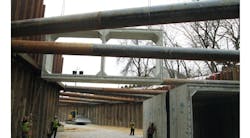Conquering a Culvert
Winters in Wisconsin can slow construction to a crawl or even halt it. So when the Wisconsin Department of Transportation (WisDOT) needed to start a project in January to hit a tight construction deadline, the contractor turned to precast concrete.
The project—the replacement of an existing culvert in Milwaukee—had an original design plan that reflected cast-in-place construction with the option of precast concrete. Given the weather and timeline, the contractor opted for precast to reduce the number of factors that could lead to delays.
“The project had tight time constraints and interim completion dates to complete the work prior to the Wisconsin State Fair at the beginning of August,” said Mike Burns, P.E., project manager for WisDOT. “There was a very limited duration to shut down interchange ramps and local roads, which presented a challenge to complete the designed cast-in-place box. The contractor chose to utilize precast sections to gain time and schedule to complete the project and reopen roadways within the given time constraints.”
The culvert diverts water from pavement-heavy sections of Milwaukee as well as the Honey Creek watershed. The existing 3-cell culvert ran under I-94 and through the Wisconsin State Fair Park and had posed many challenges for the state. Even small amounts of rain upstream created a fast rise in water levels, which led to flash flooding. For the culvert replacement, which was prompted by the planned reconstruction of I-94 at that location, WisDOT opted to increase the waterway with a 4-cell design.
The precast concrete was manufactured by Wieser Concrete Product’s plant in Portage, Wis., in twin-cell, monolithic sections placed side-by-side on site. A majority of the sections have two interior open areas with 12 ft of span and 10 ft of rise and weighed 60,000 lbs. To finish the project before the Wisconsin State Fair, the company began pouring sections in January and had completed the production process by June. Special sections were cast to account for pipe inlets, as well as connections with junction chambers. The pieces were poured with a self-consolidating concrete mix design that exceeded the 6,000 psi requirements.
“We poured 504 twin-cell sections for the project and about six pieces per day,” said Mark Wieser, vice president of Wieser Concrete Products. “The speed of the production and installation of the precast was something the state needed for this job, especially with the project starting in the middle of winter.”
WisDOT started installation of the pieces in February and was able to set as many as 25 to 30 pieces a day during one of the coldest winters on record in the Midwest. The result is a 4-cell culvert that finished on time, runs 1,250 ft and is capable of handling the runoff for decades to come.


